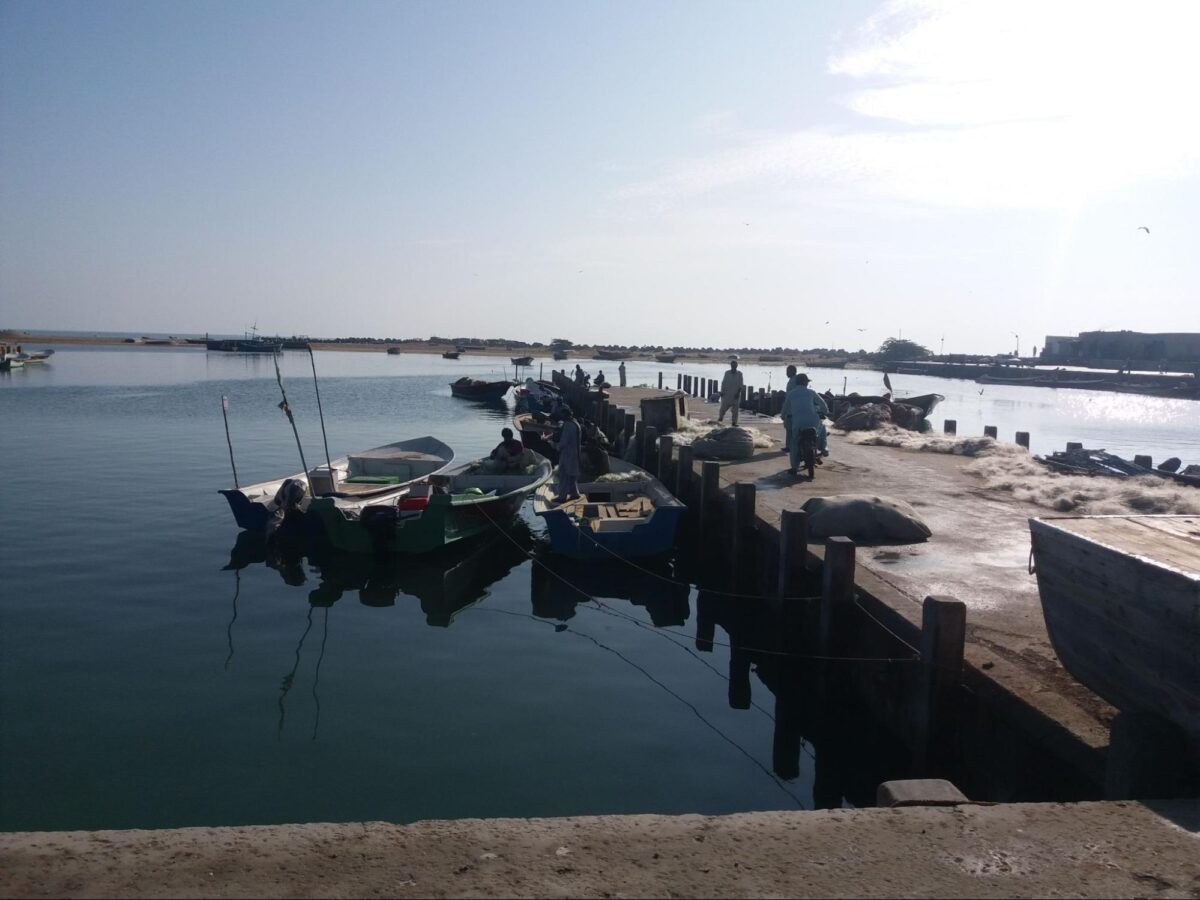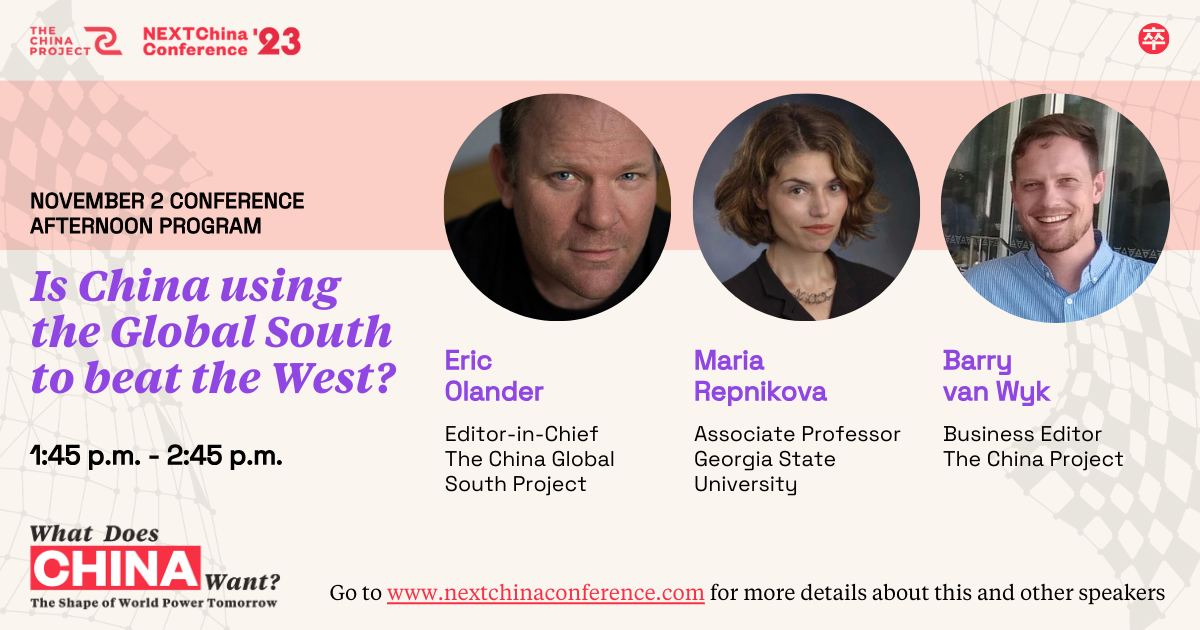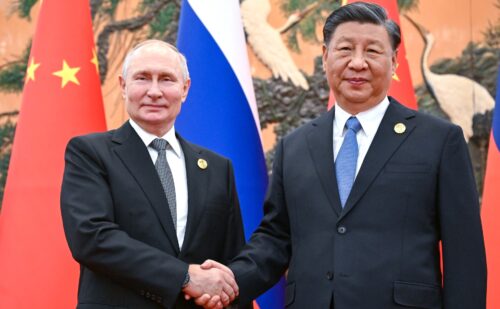China in limbo over importing Middle East oil overland through Pakistan
Ongoing violence in Balochistan and Xi Jinping’s shifting Belt and Road priorities may end Pakistan and China’s pipeline dreams.

If China wants to move Middle Eastern oil and gas overland to Xinjiang, it must dredge the port at Gwadar, build a refinery there, then construct a high-altitude pipeline through Pakistan’s most unstable region.
These promised, massive, and expensive projects must have been front-of-mind when Pakistan’s caretaker, Prime Minister Anwaar-ul-Haq Kakar, arrived in Beijing on October 17 for the third Belt and Road Forum for International Cooperation.
Kakar joined dozens of leaders from the Global South to mark the 10th anniversary of the Belt and Road Initiative (BRI), the signature push for global infrastructure and energy projects that Xí Jìnpíng 习近平, China’s top leader and General Secretary of the Communist Party of China (CCP), has billed as a revival of the ancient Silk Road to boost global trade.
Since China imports 73% of its oil, and 60% of that oil comes from the Middle East, it makes sense for Beijing to try to find a faster route for oil and gas. Currently, 80% of its oil imports are shipped through the Strait of Malacca, between Malaysia and Indonesia. If a conflict were to arise in the South China Sea between China and its neighbors Taiwan or the Philippines, or with the United States Navy patrolling the region, China’s oil supply could be disrupted.
A pipeline for oil from the Persian Gulf through Pakistan over the Karakoram mountains to China would be an immense engineering challenge. But even more problematic is the separatist and sectarian violence in much of the area such a pipeline would traverse. Gwadar, the port in Pakistan’s southwestern Balochistan Province, where separatist violence has slowed development, would be a key node. The port, considered to be the crown jewel of the $60 billion China Pakistan Economic Corridor (CPEC) and the epicenter of the BRI, “remains underdeveloped and lacks basic facilities despite being a high priority for Beijing,” Pakistan’s Express Tribune reported upon Kakar’s arrival in China.
But Beijing is not entertaining many demands for further investment in CPEC. Pakistan’s point person, Fawad Hasan Fawad, said in early October that China had put up only $25 billion so far and that Islamabad had failed to take even 20% benefit from the BRI and CPEC, the Express Tribune reported.

Too shallow
Gwadar is 50 miles east of Pakistan’s border with oil-rich Iran, but its harbor is too shallow to receive oil tankers large enough to make transshipment economical. The port would have to be dredged in order to handle large crude vessels (VCVs) and ultra-large crude vessels (ULCVs).
Jamil Jangian, a master marine superintendent serving a vessel docked at Gwadar that belongs to Sea Ocean Shipping of the United Arab Emirates (UAE), said that the port, at 14.5 meters depth, is unable to handle LCVs and ULCVs.
“For a port to receive LCVs and ULCVs, a depth from 18 to 20 meters is required,” Jangian told The China Project.
Until Gwadar is dredged, oil could be taken ashore via a floating jetty connected to pipelines located in the seabed. Such a single-point mooring (SPM) facility now services the Cnergyico Refinery, Pakistan’s largest, nearly 10 miles offshore at the southwestern city of Hub, east of Gwadar. The SPM currently offloads oil from vessels of 100,000 deadweight tonnage (DWT), with plans to be able to handle VLCVs of up to 250,000 DWT.
“This system has been designed to accommodate deep-draft oil tankers,” Jangian said. “As far as Gwadar is concerned, I don’t think they would set up such a facility to handle oil tankers, as they would dredge it to 20 meters in depth as per the port Master Plan.”

Unfulfilled promises
Approved in 2006, the Gwadar Port Master Plan promised to benefit the people of Balochistan through the flow of oil and other petroleum products. When China and Pakistan launched CPEC in 2013, Gwadar locals hoped their port would get an additional boost, a promise China has made ever since.
“One of the main purposes of CPEC was to help the locals in Gwadar, benefit them, and pull them out of poverty,” Jiāng Zàidōng 姜再冬, China’s ambassador to Pakistan since September 2023, told The China Project. “They need to have jobs, economic opportunities to benefit from the CPEC projects in Gwadar.”
Yet many locals have said they were left out of planning the port’s upgrade.
“Following the launch of CPEC, a few roads were constructed in Gwadar district, but overall, the locals have not witnessed any improvement in their socioeconomic conditions,” Gwadar resident Shah Meer Baloch told The China Project. “The people still face an acute power crisis, long electricity blackouts, and lack of health facilities. We don’t have any concern about dredging the port, as it’s not going to change the status quo in the port city.”
But local dissatisfaction pales in comparison to the feelings of the separatists, including Baloch rebel groups, whose occasional violent attacks against China-backed investments and Chinese engineers clearly express a desire for Beijing to quit Balochistan and close down Gwadar. They see Beijing as Islamabad’s partner in the exploitation of indigenous resources.
The new Great Game
Over the past few decades, Gwadar has transformed from a small fishing village into a strategic port.
China began investing in Gwadar in 2007, and Chinese Overseas Port Holdings (COPHC) took over Gwadar in 2013, piquing U.S. interest. Subsequent Saudi plans to construct an oil refinery spanning 13,000 acres at Gwadar were viewed by some locals as a U.S. maneuver to gain a strategic foothold through a reliable Gulf partner, a move designed to counter Chinese initiatives in the port.
A senior Pakistan government official said that a 15-member delegation from state oil giant Saudi Aramco visited Gwadar in 2019 to do a cost-benefit analysis for a 10 billion-ton refinery.
“Commercially, it was not viable to them,” the official told The China Project on condition of anonymity. “After that, China showed interest. They did commercial feasibility, as well as the economic and strategic analysis as well.”
Mumtaz Baloch, University of Balochistan political science department chairman, said that Saudi interest in Gwadar reflected interest from ally the U.S., which began to eye Gwadar following China’s arrival under CPEC.
“Anyone can come to invest $5 billion dollars, but there are financial risks,” Baloch told The China Project. “Saudi Arabia could not take risks, which is why it went away from Gwadar.” Saudi interest shifted to setting up a refinery in Gaddani, near Karachi, Pakistan’s most populous city, “because Saudis are interested in commercial aspects of the project, not geopolitical,” the government official said.
In October 2022, the newly-appointed U.S. ambassador Donald Blome visited Gwadar, where he met Pasand Khan Buledi, the chairman of Gwadar Port Authority, and other important officials and members of the community. Blome reiterated American support for trade, business, logistics, and local fisheries, and expressed U.S. desire to grow investment in the region.
“The U.S. Ambassador’s visit to Gwadar showcases that the U.S. is developing its ties with Pakistan strategically,” Muhammad Aamir Rana, director of the Pakistan Institute for Peace Studies, a think tank in Islamabad, told The China Project. “It has indeed raised concerns in Beijing which not only has significant economic but also strategic investments.”
Rana said that change of governments in Pakistan was a big obstacle. China’s investment was slow to bear fruit. “Now, they are back on the scene to set up the oil refinery,” he said.
Soon after Amb. Blome’s Gwadar visit, Pakistan’s Foreign Office reaffirmed Islamabad’s ties to Beijing.
“We consider Gwadar the jewel in the crown of Pakistan-China cooperation under the CPEC,” Mumtaz Zahra Baloch, Foreign Office spokeswoman told reporters. “We have always welcomed foreign dignitaries and diplomats to visit Gwadar and see its potential as a game changer for prosperity in the future.”
Some observers see Gwadar’s role simply as an economic epicenter of the CPEC, while others see the potential for a flow of a strategic commodity such as oil moving through port as part of a much larger dynamic.
“Many people in Pakistan think Gwadar has got a strategic motive — sort of a part of a ‘Great Game,” Hafeez Jamali, author of A Harbor in the Tempest: Megaprojects, Identity, and the Politics of Place in Gwadar, Pakistan, told The China Project.
Professor Baloch, a Gwadar local, believes such a contest pits China against the U.S. and its Gulf allies: “The Saudis are close to the U.S. and they both are on the same page,” he told The China Project.
“The recent visit of the U.S. Ambassador indicates the growing U.S. interest in Gwadar, where China has a footprint,” Baloch said. “[Gwadar] borders Iran, the arch-rival of the U.S. As for Iran, it provides oil to Pakistan, and Pakistan does not trade legally with Iran due to fear of America.”
Despite Islamabad facing a fine of $18 billion in March 2024 if it does not complete its part of a 1,677-mile pipeline to import natural gas over the border from Iran, Pakistan put the construction on hold because, analysts said, of Islamabad’s fear of Washington’s sanctions over Tehran’s nuclear program.
Would Pakistan similarly abandon China’s CPEC investments under U.S. pressure?
“No,” Khalid Waleed, an energy economist at the Sustainable Development Policy Institute think tank in Islamabad, told The China Project. “The Sino-Pakistan relations are strategic. Unlike Iran, with U.S. sanctions, Pakistan cannot abandon the Chinese-funded projects.”
However, “China has become shy now to invest because it does not get the returns,” Waleed said. “As for Pakistan, due to its shambling economy, it is in dire need of investments from other countries, including China, but the ball is in China’s court.”
Refinery plans
China’s East Sea Group Limited (ESGL) — which is involved in oil refineries, and the trade, shipment, and storage of oil and oil products in Southeast Asia, the Middle East, and South America — is committed to building a $4.5 billion oil refinery at Gwadar with a starting annual capacity of 5 million tons.
“There is a shortage of energy in Pakistan, which is why we have signed some contracts to set up an oil refinery in Gwadar,” Peter Qu Tao, ESGL assistant to the Director of Overseas Projects, told The China Project.
“Our priorities are people-centric in Gwadar,” Qu said, adding that Chinese companies want to help Gwadar set up schools, technical centers, and other support for locals, “to help them in any way possible.”
Gwadar Port Authority Chairman Pasand Khan Buledi said that ESGL’s refinery was in its “initial stage so far.”
“The investors see viable, workable places, which suits their businesses,” Buledi told The China Project.
Gwadar Port Authority sources told Pakistan’s Dawn newspaper that ESGL bought land in Gwadar in collaboration with China Overseas Port Hold Company (COPHCO), and that the refinery would be built there in two phases.
After completion, ESGL said it will raise the refinery’s annual capacity to 8 million tons, and, in its second phase, receive six crude oil transshipment vessels at Gwadar so that the company can support its own oil business and provide transshipment for Middle East producers.
In March 2023, when Beijing brokered a peace agreement between Pakistan’s oil-rich neighbor Iran and its historical rival Saudi Arabia, leaving Washington out of the petro-diplomacy loop, the value of Gwadar rose as a potential transshipment point in the global oil trade.
“With the Saudi-Iran détente, China may get oil from Iran via Pakistan’s Gwadar, which is situated at the border,” Shah Muhammad Marri, a Baloch author and historian, told The China Project from Quetta. “On the other hand, Saudi Arabia is rich in oil, and it can provide oil as well, especially to the refinery.”
Pipeline or pipe dream?
Moving Middle Eastern oil by ship from Dubai the 6,627 nautical miles to Shanghai takes 28 days. In theory, moving the same oil via pipeline from Gwadar the 5,033 miles overland to Shanghai would take roughly 19 days.
The first part of that journey might be the toughest — the 1,087 miles from Gwadar to Kashgar, in the Xinjiang Uyghur Autonomous Region. Just that section of pipeline would require a pumping station every 75 miles, a National University of Computer and Engineering Sciences economic assessment of the plan from 2013 showed. That’s 14 stations that demand a lot of security.
When China and Pakistan first announced they would run the 1m-diameter pipeline the full distance from Gwadar to Kashgar, it was priced at $12 billion and designed to carry 27 million tons of oil to Xinjiang each year. It was set to finish in 2018, but, since its inception, Balochistan, Pakistan’s poorest province, has been rocked by separatist violence that often targets Chinese engineers and development projects.

“To my knowledge, this pipeline project has been abandoned or canceled at the moment,” Jan Muhammed Baloch, a political analyst and researcher told the China Project. “Khunjerab Pass is 15,000 feet above sea level. The pipeline must be heavily pumped. Moreover, the terrain, geography, freezing temperatures, frequency of natural disasters such as earthquakes, landslides, and glaciers are the other hazards and hurdles, which has made the Himalayan pipeline too expensive and challenging.”
Citing the Atacama gas pipeline, which is 16,400 feet above sea level in Chile, Professor Tousif Akhtar, chair emeritus of the University of Balochistan Economics Department, expressed hope that China and Pakistan could conquer the landscape.
“It is difficult and expensive to lay an oil pipeline from Gwadar to Xinjiang, yet not impossible. The advanced technology can however help overcome these logistical hurdles,” Akhtar told the China Project.
Shifting gears?
On October 15, 2023, the Chinese state-run newspaper Global Times published an op-ed in which Kakar, who is from Balochistan but not Baloch himself, voiced full-throated gratitude for China’s support of Pakistan. On his way to meet Xi, Kakar invoked a recent Chinese State Council white paper outlining the Chinese leader’s new concepts for the BRI: a Global Development Initiative, a Global Security Initiative, and a Global Civilization Initiative — all of which, Kakar said, Pakistan supported.
Recalling the foreign policy objectives of Pakistan’s founding father, Muhammad Ali Jinnah — “peace within and peace without” — Kakar wrote, “It was, therefore, all but natural for Pakistan to endorse these key initiatives put forth by President Xi.”
Meeting Xi, Kakar was expected to sign a deal for Chinese engineers to help Pakistan upgrade the Karakorum Highway to be usable even in winter, key to moving material for building a pipeline up and over the mountains to Xinjiang.
Kakar and Xi also were expected to agree to allow China to build a $53 million training center on 530 acres of land to carry out “indigenous research in various faculties of highway engineering not limited to pavements, bridges, tunneling environmental engineering, hydraulics and Geotech, but also covering technical training,” the daily Dawn reported.
After the meetings, Xi said both countries “build an ‘upgraded version’ of [CPEC] featuring growth, livelihood, innovation, greenness and openness, strengthen cooperation in areas like industrial park, agriculture, mining and new energy, and promote the early implementation of major connectivity projects and the achievement of practical results.” But Xi also warned Pakistan that it should “guarantee the safety of Chinese institutions and personnel in Pakistan.”
Given ongoing violence in the region, some doubt anybody’s ability to make any of these big energy infrastructure projects a reality any time soon.
“Under the present deteriorating security situation in Balochistan and elsewhere in the country, I don’t think China can go ahead smoothly with an oil refinery,” Abdul Rahim Zafar, a senior politician based in Gwadar, told The China Project.
A Chinese official speaking of security in Pakistan told The China Project: “The investors are like birds on a tree. If a single shot is fired, all of them fly.”







